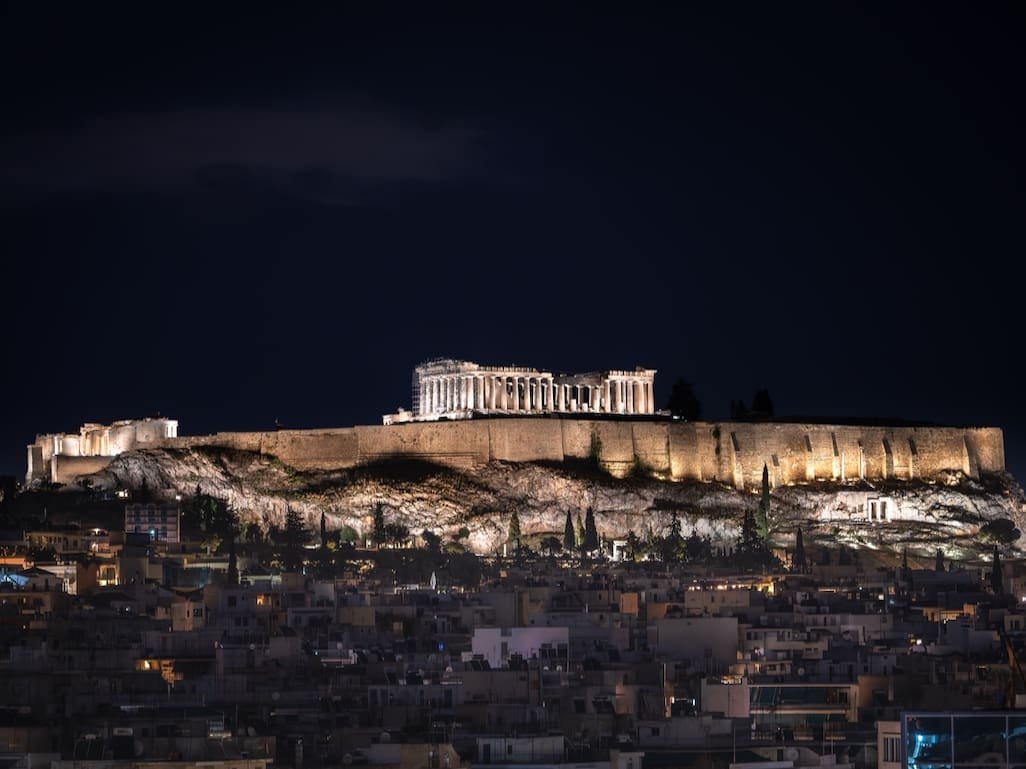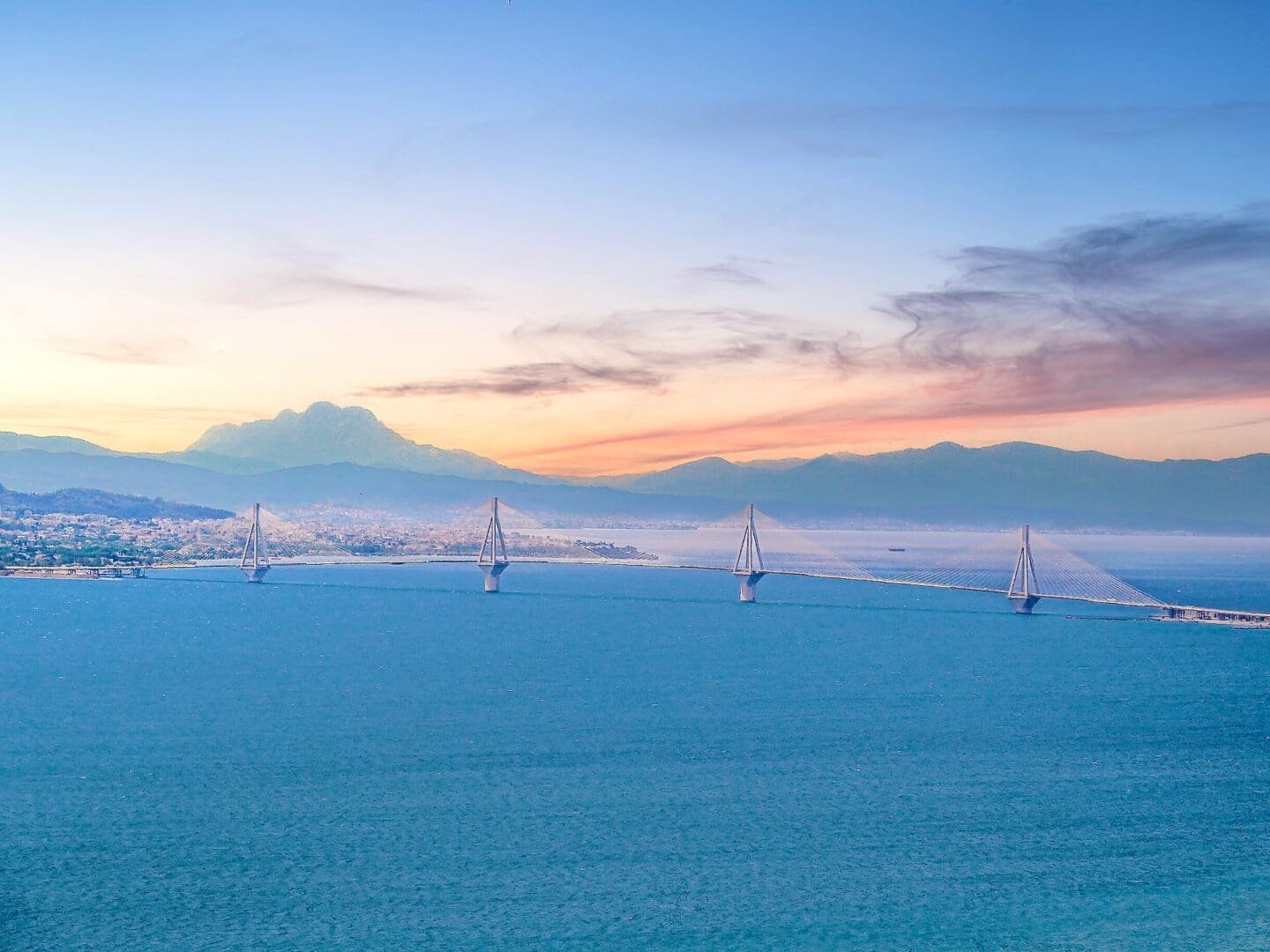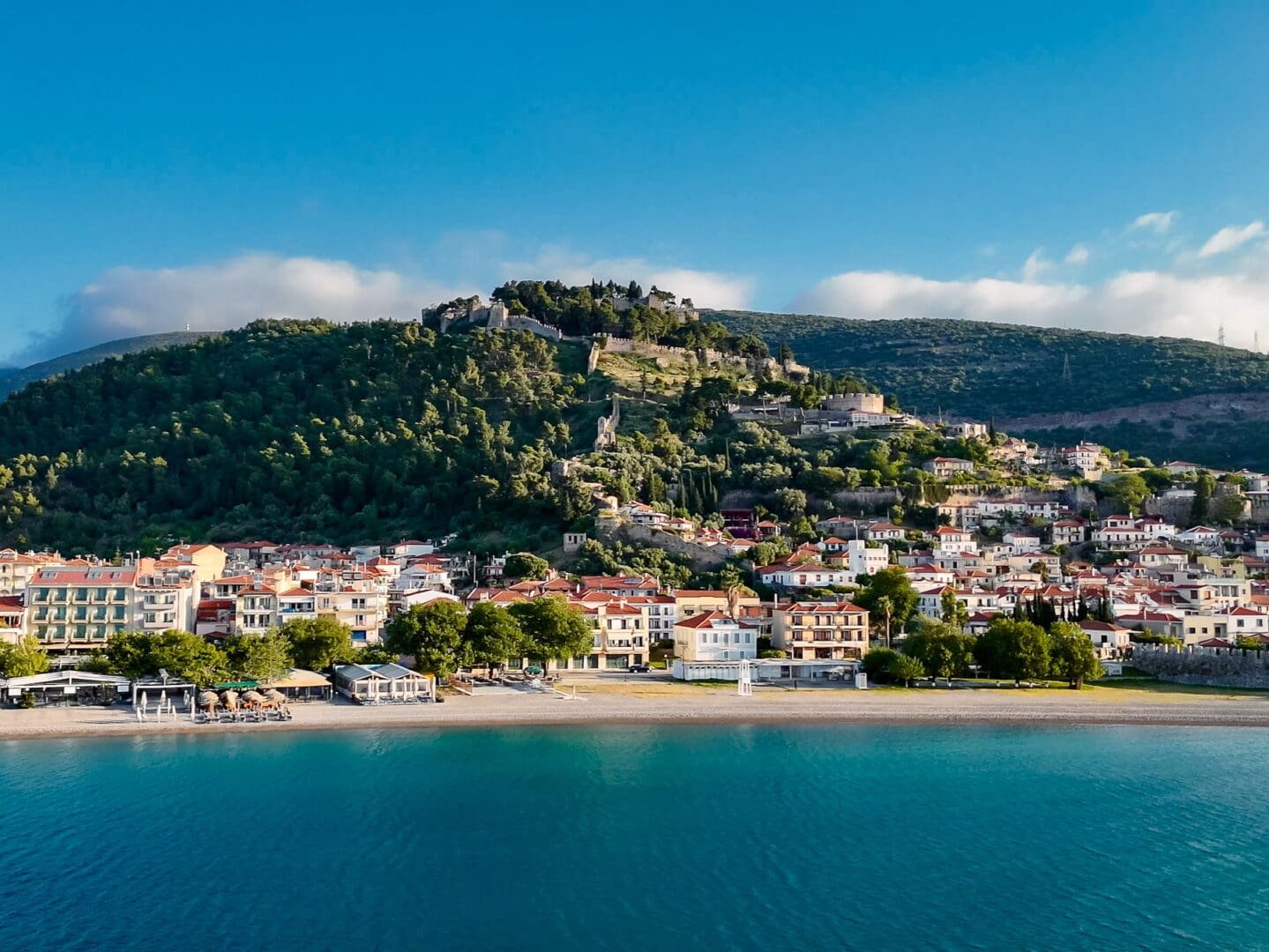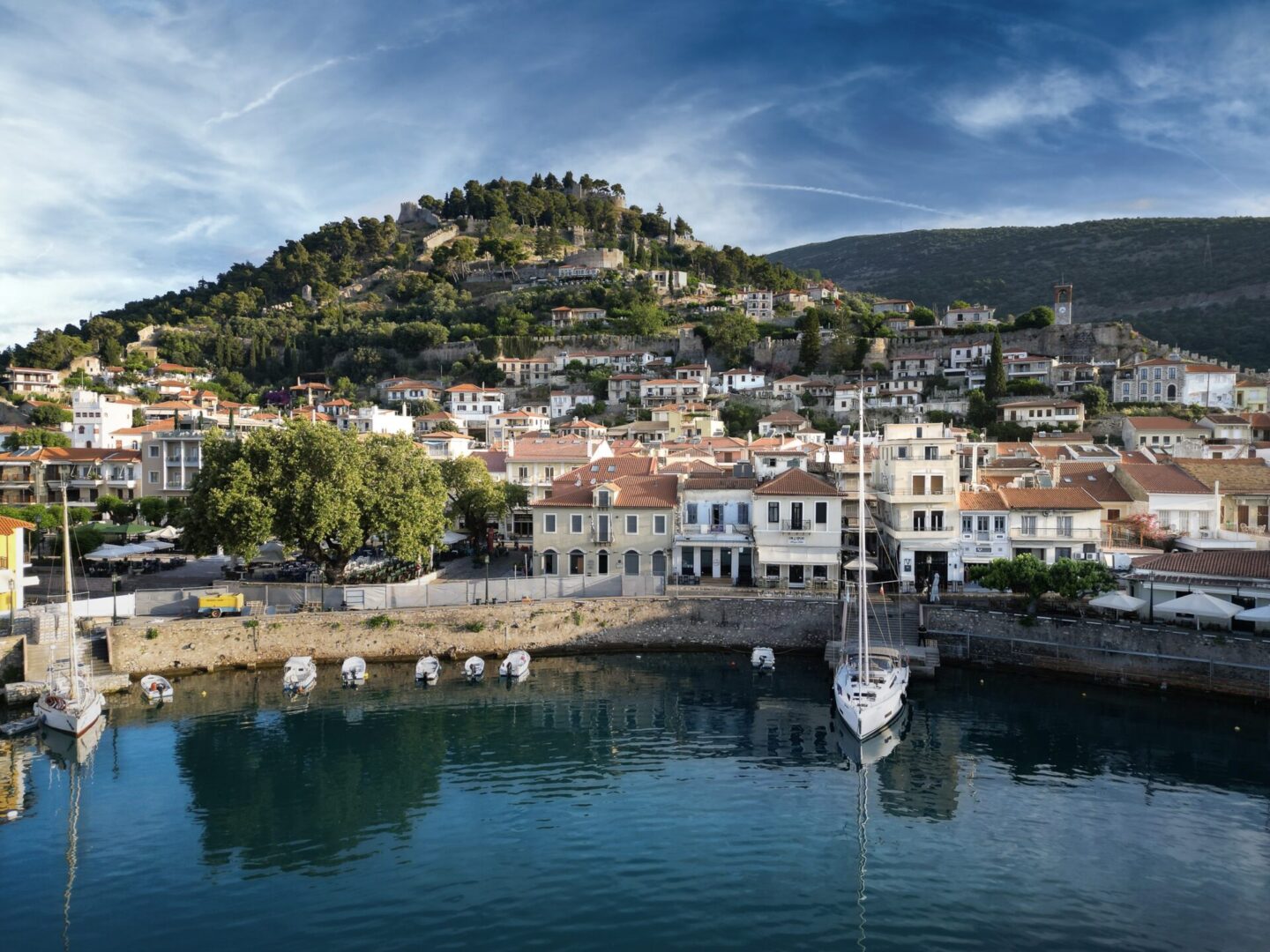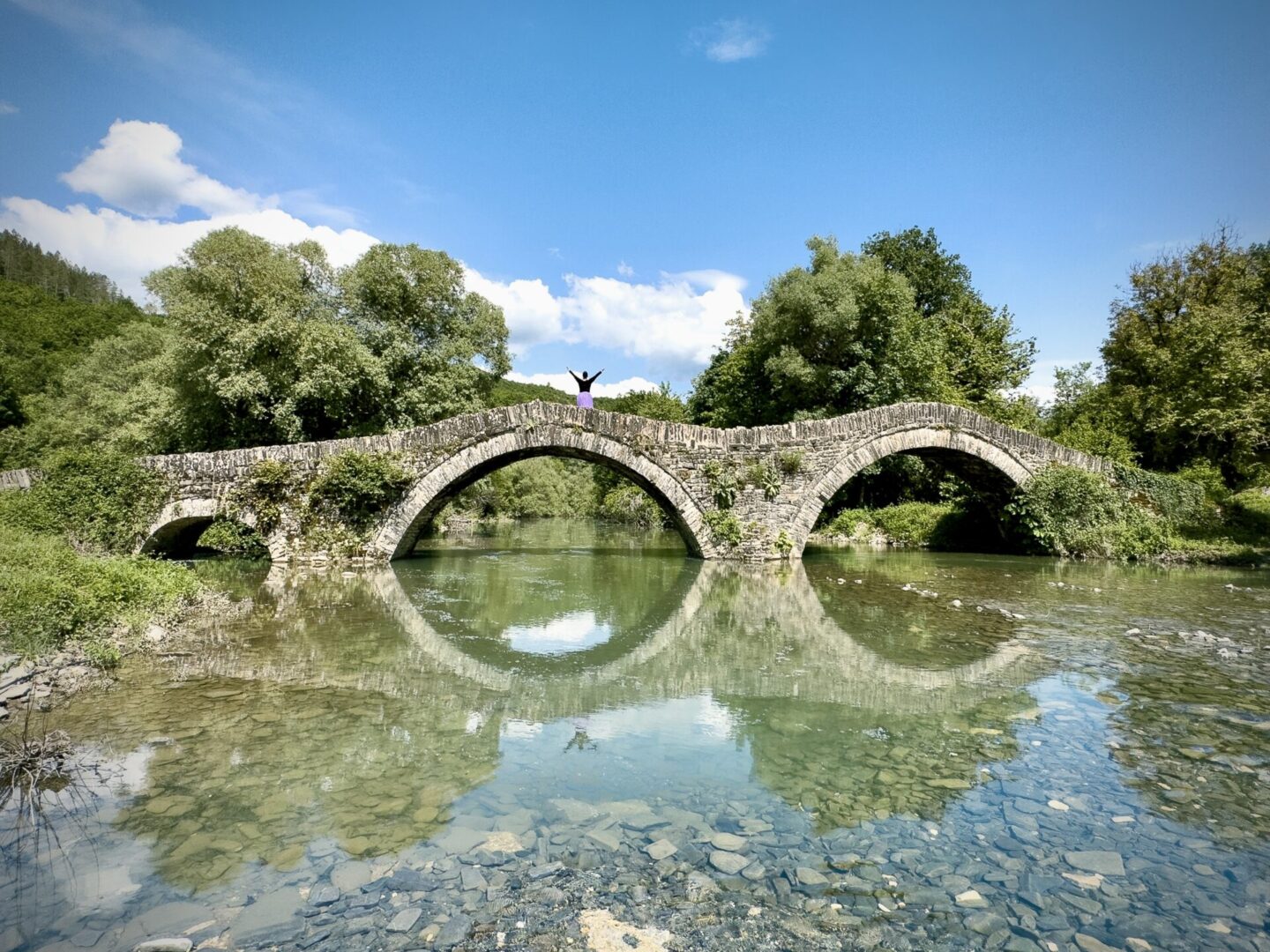
Bridges in Greece delight and dazzle the traveler, the photographer, the historian, and the architecture aficionado alike.
This ancient yet ever-new land offers an impressive array of both award-winning and history-making bridges to explore, experience, and inspire your imagination.
So whether you simply appreciate the artistry, beauty, and poetry of bridges – or you’re dreaming and planning travel to Greece – we’ve included bridges from famous modern spans to historic hidden gems.
You’ll also find a custom interactive map showing all the locations of these unique and beautiful Greek bridges. As well as travel tips, including our firsthand observations and top recommendations of where to stay.
Additionally, each bridge entry includes “Notes on Greek Names.” These brief notes present common alternative spelling options due to differences in transliteration between the Greek alphabet and English.
For example, the word “bridge” is γέφυρα in Greek. The two English transliterations of gefyra and gephyra are both correct.
Ready? Πάμε, let’s go!
- Most Famous Bridge in Greece
- Modern Bridges in Greece
- Floating Bridges in Greece
- Stone Arch Bridges in Greece
- Ancient Bridges in Greece
- Bridges in Greece: History and Mythology
- Interactive Map of Bridges in Greece
- Bridges in Greece: Ancient Sources
- Bridges in Greece: Modern Resources
- Check Out More Recommendations
- Bridges in Greece: FAQs
When you book or purchase through some links, Spotlight Sojourns may earn a small commission at no extra cost to you. Thanks for using our affiliate links!
Most Famous Bridge in Greece
Charilaos Trikoupis Bridge, Rio-Antirrio, Western Greece
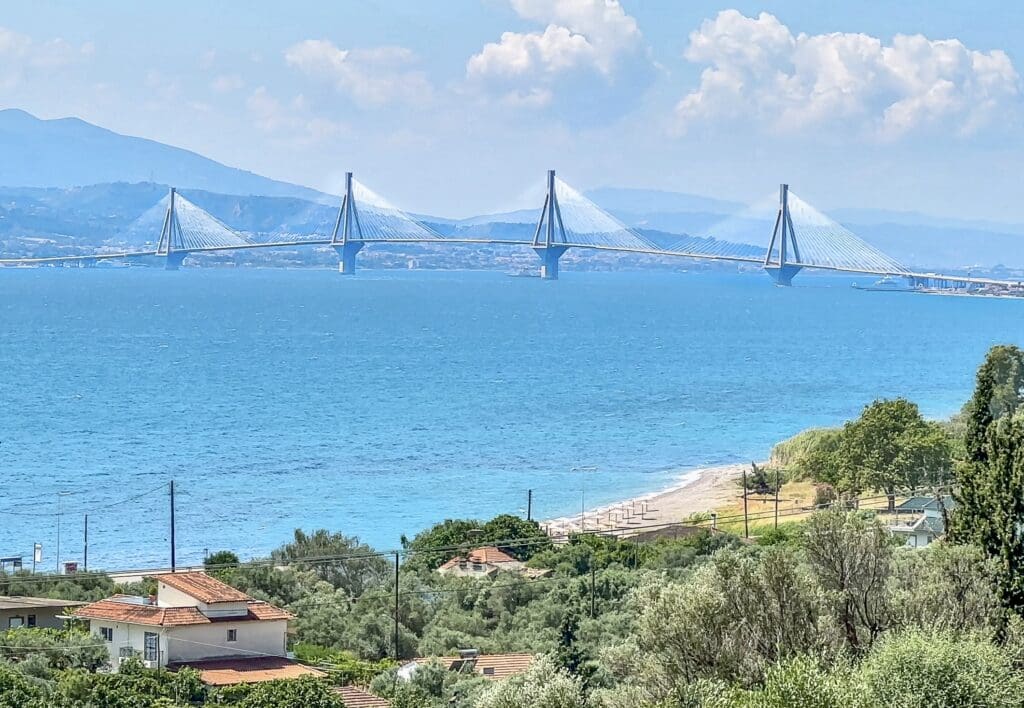
The most famous bridge in Greece is also the longest bridge in Greece: the Charilaos Trikoupis Bridge, perhaps better known as the Rio-Antirio Bridge.
Spanning the majestic Gulf of Corinth, this monumental bridge connects the Peloponnese peninsula to mainland Greece.
Its official name, Charilaos Trikoupis Bridge, pays tribute to the statesman who first proposed the idea in the 1880s: 19th-century Prime Minister of Greece Charilaos Trikoupis.
Its informal name, Rio Antirio-Bridge, honors the two historic port towns on each end.
Rio, now a suburb of metropolitan Patras, anchors the approach viaduct on the Peloponnese peninsula. Antirio, in Nafpaktia, anchors the approach viaduct on the Western Greece mainland.
It’s a formidable feat of modern engineering to overcome serious challenges, for instance, deep water, far distance, high winds, heavy traffic, and seismic activity.
The main bridge is a cable-stayed fully suspended deck, 1.4 miles (2,252 m) in length.
On August 7, 2004, Olympic torchbearers with the Olympic flame were the first across the Rio-Antirio Bridge on Opening Day.
Twenty years later, several prestigious international awards – not to mention many, many millions of vehicles – attest to the enduring success of the Charilaos Trikoupis Bridge.
Rio Address: Charilaos Trikoupis Bridge | Ionia Odos A5 | 26504 Rio, Patras, Greece
Antirrio Address: Charilaos Trikoupis Bridge | Ionia Odos A5 | 30020 Antirrio, Nafpaktia, Greece
Charilaos Trikoupis Bridge Travel Tips
The Charilaos Trikoupis Bridge ranks in its own right among the best bridges in the world.
And, of course, it’s a memorable experience to drive – or walk! – across one of the world’s longest fully-suspended bridges.
It’s an unforgettable sight to see this phenomenal and beautiful bridge at sunrise and sunset.
Check out the best places to stay in Nafpaktos, a Venetian gem of a town with magical bridge views.
Enchanting on its own, Nafpaktos is the perfect place to stay to see the Charilaos-Trikoupis Bridge at dawn and dusk.
The Nafpaktos Travel Guide provides lots of detailed information to plan your visit.
Charilaos Trikoupis Bridge: Notes on Greek Names
The official name, Charilaos Trikoupis Bridge (Γέφυρα Χαρίλαος Τρικούπης), is also spelled as Xarilaos Trikoupis Bridge and Harilaos Trikoupis Bridge.
The informal name, Rio-Antirio Bridge (Γέφυρα Ρίου–Αντιρρίου), is additionally spelled as Rio-Antirrio Bridge and Rion-Antirion Bridge.
Modern Bridges in Greece
Katehaki Bridge, Athens, Attica
Superstar architect Santiago Calatrava created several spectacular commissions for the Athens 2004 Olympic Games.
From the Opening Ceremony to the fabulous finale, the August 2004 Summer Olympics “dream games” unfolded at Calatrava’s Olympic Sports Complex and other Olympic venues.
The “starchitect” Calatrava also designed and built a significantly smaller structure in Athens: the Katehaki Pedestrian Bridge.
The Katehaki Bridge is a contemporary cable-stayed bridge over busy vehicle traffic on the Mesogeion Avenue underpass.
This concrete and steel footbridge is seemingly simple yet quite complex.
The single-span deck runs 307 feet (94 m) in length. Slightly offset at one end, a single curved pylon soars 164 feet (50 m) into the air above the bridge.
Vehicle drivers and passengers zooming below miss the poetic bridge architecture above their heads.
The Katehaki Bridge is thus another reason why the Greek capital can be a wonderfully walkable city.
Address: Katehaki Bridge | Leof. Mesogeion 136-138 | 11527 Athens, Greece
Katehaki Bridge Travel Tips
The Katehaki Bridge serves the Katehaki Station, located in Athens’ Goudi neighborhood.
Residences, churches, businesses, hospitals, and sports facilities from the Athens 2004 Summer Olympics fill Goudi’s busy streets.
Since the Katehaki Station is on the Athens Metro M3 line, public transport via the Metro is logically the best way to visit the bridge.
Athens Metro Line 3, the Blue Line, runs from Athens International Airport “Eliftherios Venizelos” (ATH) to Dimotiko Theatro in Piraeus.
Besides the bustling Athens Airport station, Syntagma and Monastiraki Stations serving the most popular tourist areas in Athens, are on the Blue Line 3.
Both Syntagma and Monastiraka further serve as interchange stations for Green Line 1 and Red Line 2.
A stairway and an escalator, connected by a correspondingly inclined ramp, allow pedestrian access from street level on either end of Katehaki Bridge.
In addition, an elevator goes directly to Katehaki Subway Station.
Katehaki Bridge: Notes on Greek Names
Athens (Αθήνα) is located in the Region of Attica (Αττική), also spelled Attiki.
The Katehaki Bridge (Γέφυρα Κατεχάκη) is also spelled as Katechaki Bridge.
Tsakona Arch Bridge, Megalopolis, Peloponnese
As you drive along the Greek national superhighway A7 / E65 through the Central and Southern Peloponnese region, get ready around Megalopoli:
Because the Tsakona Bridge comes quickly and crosses seamlessly. With no stops on this stretch of high-speed modern roadway.
And because there are no stops here, you won’t want to miss one of the world’s longest multi-span arch bridges.
Opened in 2016, the Tsakona Arch Bridge carries vehicle traffic over the Tsakona Valley.
Earthquakes and landslides are a frequent concern here in southern mainland Greece. A major landslide, in fact, compelled this road bridge solution.
The multi-span Tsakona Arch Bridge extends 0.3 miles (490 m) in total length.
The main bridge is 984 feet (300 m) full length. The main deck is fully suspended by two vertical parabolic steel arches rising 98 feet (30 m) high.
The Tsakona Bridge design and construction is functional engineering in action. Which befits a road bridge carrying millions of vehicles between Attica, Central Peloponnese, and Southern Peloponnese.
Address: Tsakona Arch Bridge | A/D Tripoleos Kalamatas | 22200 Megalopolis, Greece
Tsakona Arch Bridge Travel Tips
Besides the Tsakona Bridge, the A7 major infrastructure is well-designed and engineered with interchanges, tunnels, and tollways.
The A7 is certainly one of the best routes on a road trip in Greece! We’ve driven the route many times between Athens and Corinth, Tripoli and Kalamata, and between Athens and Sparta.
As described above, let’s use Athens International Airport “Eliftherios Venizelos” (ATH) as the standard point of reference in driving distance and travel time.
The driving distance from Athens airport to the Tsakona Arch Bridge is approximately 143 miles (230 km).
The travel time from Athens typically takes about 2.5 hours.
Travel time will vary, of course, depending on prevailing traffic and weather conditions. As well as the amount of stops at the motorist rest areas.
Besides gas stations, there’s quite good food and specialty coffee at the A7 service stations.
Tsakona Arch Bridge: Notes on Greek Names
The Tsakona Arch Bridge (Τοξωτή Γέφυρα Τσακώνας) basically has this one simple and straightforward transliteration.
Floating Bridges in Greece
Lefkada Bridge, Lefkada, Ionian Islands
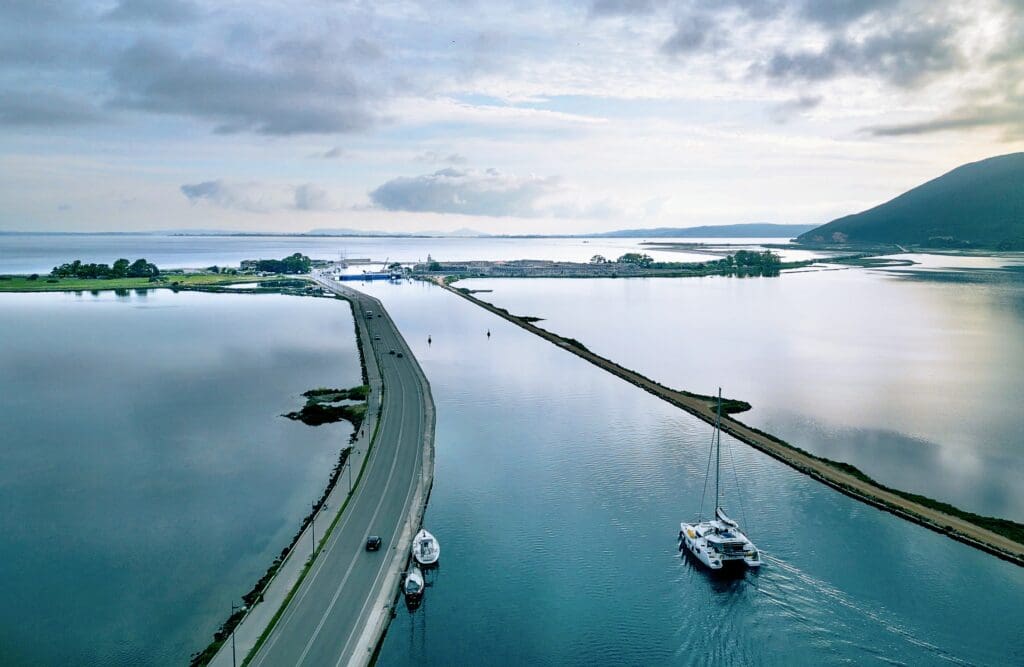
Lefkada is an island known for beautiful beaches like Porto Katsiki and popular beach towns like Nidri along the crystal-clear Ionian Sea.
And Lefkada is an island known for its rather uncommon access.
Because Lefkada is a Greek Island with a road bridge to mainland Greece.
Thanks to this short bridge and a long causeway, you can drive directly from the Northwestern Greek mainland to Lefkada Island in the Ionian Sea.
The Floating Bridge of Agia Mavra as it’s formally known, is named for the landmark Venetian fortress Santa Maura (Saint Mary), guarding Lefkada since the 14th century.
Opened in the mid-1980s, the steel pontoon road bridge not only floats but also rotates.
Its two-fold purpose allows vehicles to drive on and off the island and boats to sail through the Lefkas Canal.
The bridge isn’t long, only 164 feet (50 m) full length. This brief length includes a steel ramp at either end that raises during the 90-degree rotation.
In short (pun intended), the Lefkada Floating Bridge rates among the unique bridges of Greece.
Address: Lefkada Floating Bridge of Agia Mavra | EO Amfilochias Lefkadas | 31100 Lefkada, Greece
Lefkada Bridge Travel Tips
Lefkada Town is the island capital and an ideal home base for bridge and island explorations.
Located in a residential neighborhood, The Victoria Lefkada lies within easy walking distance of historic Lefkada Old Town and Lefkas Canal.
The Victoria Lefkada offers 19 luxury suites centered around a posh, private swimming pool and courtyard.
The entire complex is well-designed, with upscale comforts. Suites on the upper floors are also fully accessible by elevator.
Each chic suite features a fully equipped kitchen and separate areas for dining, seating, and sleeping. A balcony completes the floor plan for studios, one-bedroom apartments, and two-bedroom apartments.
Check the dates and best rates for your stay HERE.
Lefkada Bridge: Notes on Greek Names
The Ionian Island Lefkada (Λευκάδα) is also known as Lefka and Leukas.
The official bridge name is the Floating Bridge Agia Mavra (Πλωτή Γέφυρα Αγίας Μάβρας). Agia Mavra refers to the Venetian castle Santa Maura (Saint Mary), as noted above.
Informally, the Lefkada Bridge is often called the Lefkada Floating Bridge and Lefkada Pontoon Bridge.
Additionally, since the Lefkada Bridge is technically classified as a vessel, the bridge displays the name F/B Santa Maura on its side.
Stone Arch Bridges in Greece
Zagorochoria Arch Stone Bridges, Zagori, Epirus
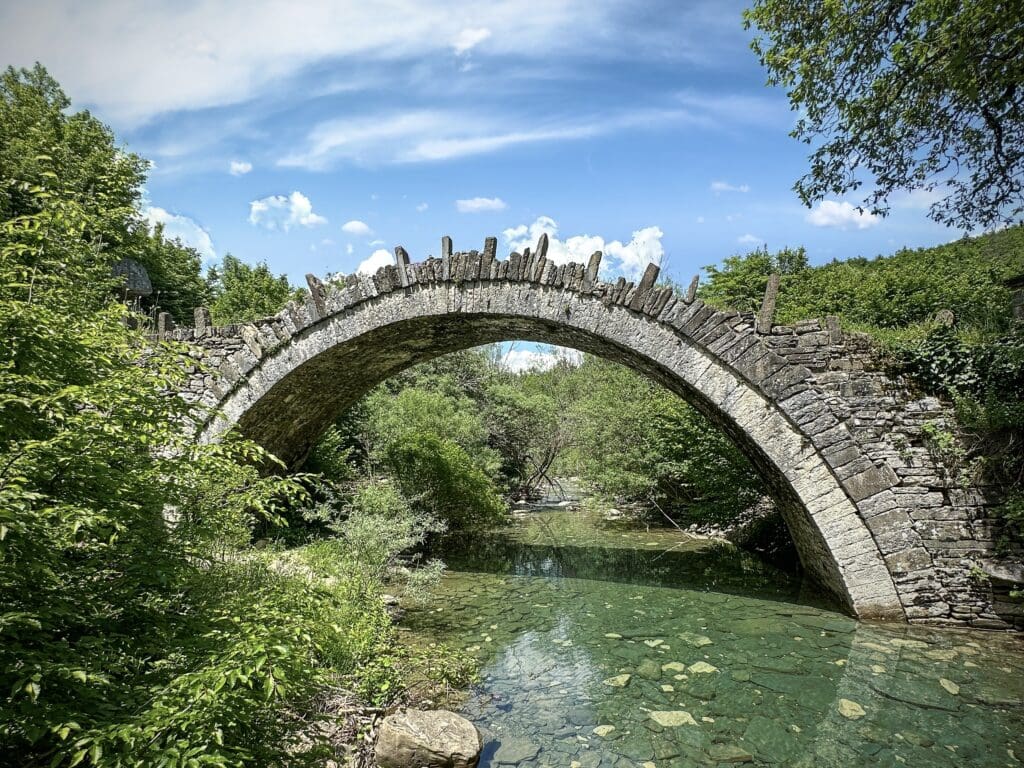
The Region of Epirus is home to Zagorochoria, Greece UNESCO World Heritage Site listed in September 2023.
Zagorochoria, i.e., the stone villages of Zagori, are traditional mountain villages in the remote Pindus Mountains.
A rugged network of stone footbridges, stone trails, and stone stairs connects these small villages, many tucked away in the forest.
Zagorochoria, Zagori, and Epirus are wonderful Greek landmarks off the beaten path.
Two arched stone bridges, in particular, are the most well-known of these rather hidden gems.
Kokkorou Bridge, Koukouli, Epirus
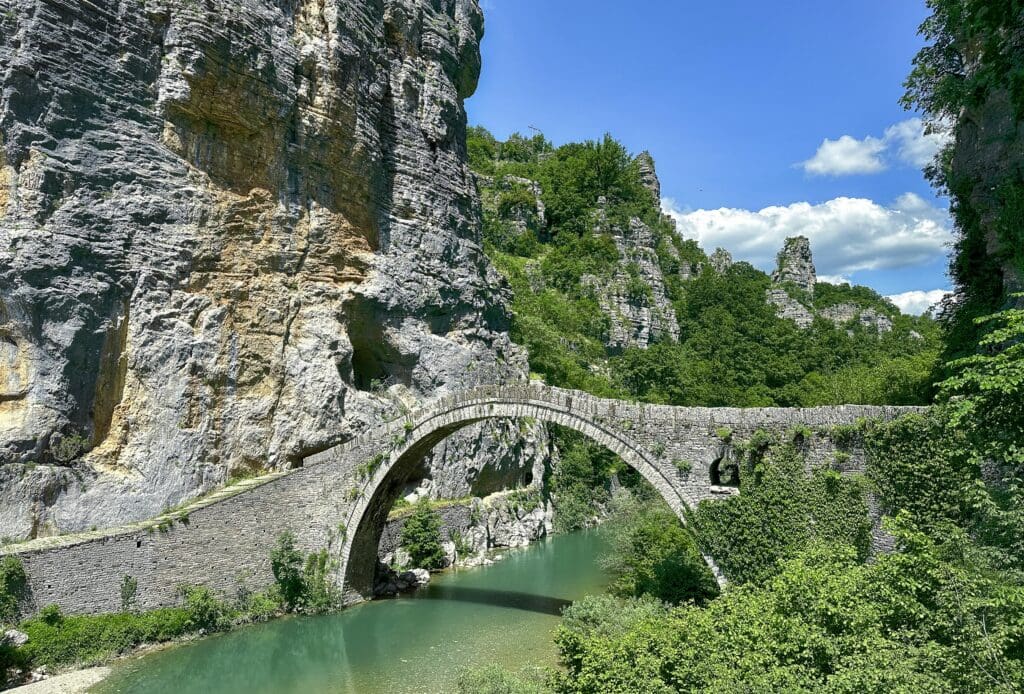
Kokkorou Bridge is a singular stone bridge with one spectacular span over the Voidomatis River. It’s an awe-inspiring welcome to the Vikos Gorge.
Built by master craftsmen circa 1750, the single-arched stone bridge measures approximately 77 feet (23.6 m) in length and 42.5 feet (13 m) in height.
The high single arch springs up between two towering rock walls. Even when the river runs dry in the warm seasons, the bridge view is breathtaking.
Kalogeriko Bridge, Kipoi, Epirus
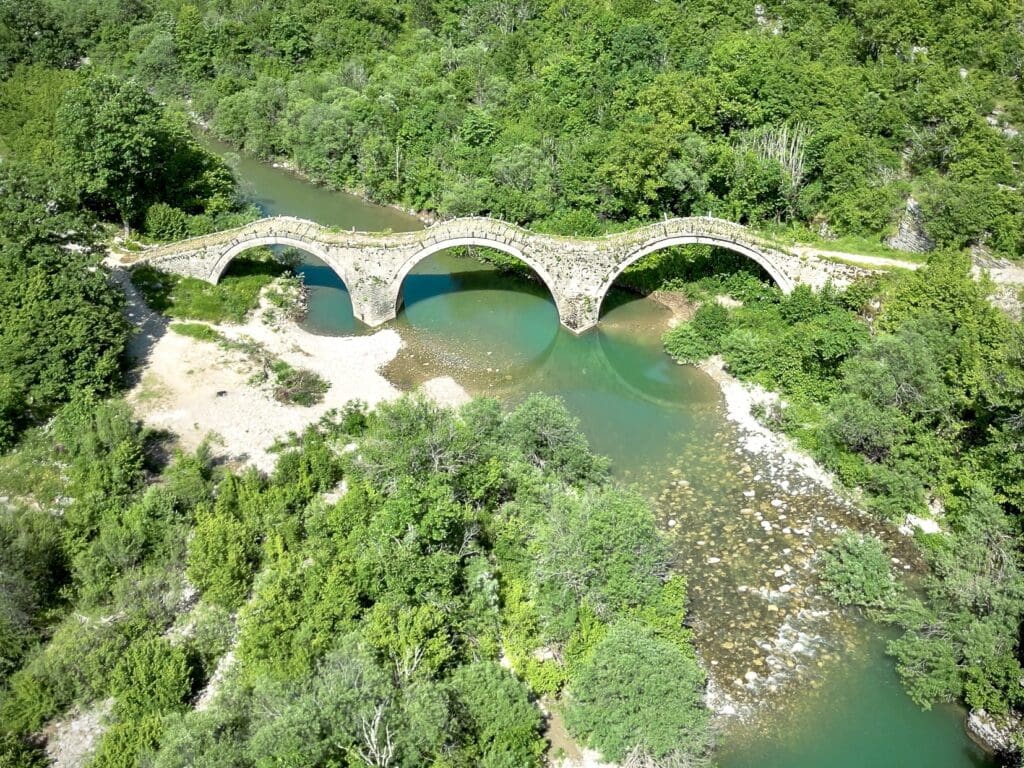
The Kalogeriko Bridge is a multi-arch stone bridge over the Vikos River near Kipoi, a charming village.
Built by local stonemasons circa 1814, the triple-arched bridge is about 84 feet (56 m) in length.
Located in the Vikos-Aoos National Park, the river flows below the village perched on the hillside above.
It’s a thrilling sight to see this beautiful stone bridge and its three arches amidst the lush green nature.
Address: Kokkorou Bridge | Ep. Od. Asfaka-Vrisochoriou | 44007 Zagori Greece
Address: Kalogeriko Bridge | Ep. Od. Metsovou-Kipon | 44010 Zagori Greece
Zagorochoria Arch Stone Bridges Travel Tips
Ioannina, the regional capital of Epirus, is a great home base to explore Zagori and visit the Zagorochoria Arch Stone Bridges.
Castrello Old Town Hospitality is a superb small boutique hotel owned and operated by a local family. Opened in 2022, the four-season hotel features modern style, high quality, and authentic hospitality.
Hotel Castrello boasts a desirable central location in Castle Ioannina. It’s an easy short walk to top attractions, the lively lakefront, and the quaint ferry to the little island, To Nisi.
Check the dates and best rates for your stay HERE.
Both the Kokkorou Bridge and the Kalogeriko Bridge are located near provincial roads accessible even to tour buses. And occasionally to wandering cows, goats, and other animals – after all, Zagori is a rural area.
Compared to the Kokkorou and Kalogeriko Bridges, some bridges in Zagorochoria are less accessible by car or bus. Other bridges require either a short or a long hike to visit.
Due to the remote setting of these bridges, and the overall importance of the UNESCO Zagori Cultural Landscape, a guided tour with transportation is a great idea.
Despite the modern roads, both locals and visitors alike still regularly cross the Zagorochoria Bridges in the same way as earlier eras, that is, on foot.
When it’s your time to cross these beautiful and historic stone bridges, the good things to bring are sunglasses, sunscreen, a hat, and water.
Above all, please wear sturdy shoes due to the uneven nature of these roughly cobbled and steeply arched stone bridges.
Zagori Stone Arch Bridges: Notes on Greek Names
Zagorochoria (Ζαγοροχώρια) means “Zagori villages” in Greek.
The Kokkorou Bridge (Γέφυρα Κόκκορη) is also spelled as Kokkori Bridge. It’s otherwise known as the Noutso Bridge (Γέφυρα Νούτσο).
The two alternative names honor two benefactors who maintained and restored the Kokkorou Bridge: Firstly, Mr. Noutsos in the late 18th to early 19th century. Secondly, Mr. Kokkoros in the early 20th century.
The Kalogeriko Bridge (Γέφυρα Καλογερίκο) is also known as the Plakida Bridge (Γέφυρα Πλακίδα).
The local Plakidis family maintained and restored the Kalogeriko Bridge in 1863 and again in 1912.
Ancient Bridges in Greece
Arkadiko Bridge, Argolis, Peloponnese
Dating from the Bronze Age, the Arkadiko Bridge is the oldest bridge in Greece and the oldest bridge in Europe still in use.
Some say the Arkadiko Bridge is the oldest bridge in the world that’s still crossable.
Archaeologists date the Arkadiko Bridge and a few other surviving Mycenean bridges to the Bronze Age, circa 1300 to 1190 BC. So
The Myceneans, an advanced civilization, built a network of roads and bridges throughout Argolida, an archaeologically rich area of the Peloponnese.
The archaic bridge and road network connected important cities, fortresses, and sacred sanctuaries such as Mycenae, Tiryns, and Epidaurus.
These ancient Greek bridges feature massive monumental stones with no mortar to hold them together.
The ancient geographer and travel writer Pausanias called these gigantic stones “Cyclopean.” Because only the mythical giant Cyclops could possess the strength to lift and position such immense stones.
The single corbel arch bridge is approximately 72 feet (22 m) full length.
Let’s consider: A Bronze Age bridge, built by hand and without mortar in the 13th to 12th century BC, is still used by locals and visitors alike in the 21st century AD – thousands of years later.
Now that is an astonishing feat of ancient bridge engineering!
Address: Arkadiko Bridge | Leof. Asklipiou 27 | 21052 Arkadiko (Kazarma), Greece
Travel Tips for the Arkadiko Bridge
The enchanting town of Nafplio on the Gulf of Argolis is the perfect place to visit the Arkadiko Bridge and other Northern Peloponnese highlights.
Besides the great hotels in Nafplio, Vida Residential Apartments is a true home-away-from-home. Built, owned, and operated by a local family skilled in hospitality, the apartments offer all the modern comforts and conveniences of home.
Additionally, the central location on the border between Nafplio Old Town and New Town gives you the best of both worlds.
Check the dates and best rates for your stay HERE.
From Nafplio to the Arkadiko Bridge, the driving distance is approximately 10 miles (16 km).
Between the Ancient Theater of Epidaurus and the Arkadiko Bridge, the driving distance is about 9.5 miles (15.2 km).
From the Archaeological Site of Mycenae to the Arkadiko Bridge, the driving distance is about 21 miles (33.2 km).
The modern road Leoforos Asklipiou / 70 connects all these delightful destinations.
During your drive along Leoforos Asklipiou / 70, look for a small brown sign on the roadside. The sign reads “Μυκηναϊκή Γέφυρα / Mycenaean Bridge” in Greek and English.
It’s the same historic marker you’ve seen elsewhere: a brown rectangle with white lettering. The sign is easy to overlook (which we did on our first pass).
Should your time permit, then you could additionally plan a hike to the other surviving Mycenean bridges in the area.
In this case, the best things to bring are sunscreen, sunglasses, a hat, sturdy shoes, and water for an Arcadian adventure.
Arkadiko Bridge: Notes on Greek Names
The full name of Arkadiko Bridge in Greek is Μυκηναϊκή Γέφυρα του Αρκαδικό (της Κάζαρμας). In English, this means “Mycenaean Bridge of Arkadiko (of Kazarma).”
You may also encounter references to Gefyra tou Arkadikou, “the bridge of Arkadiko.”
Aqueduct, Kavala, Eastern Macedonia and Thrace
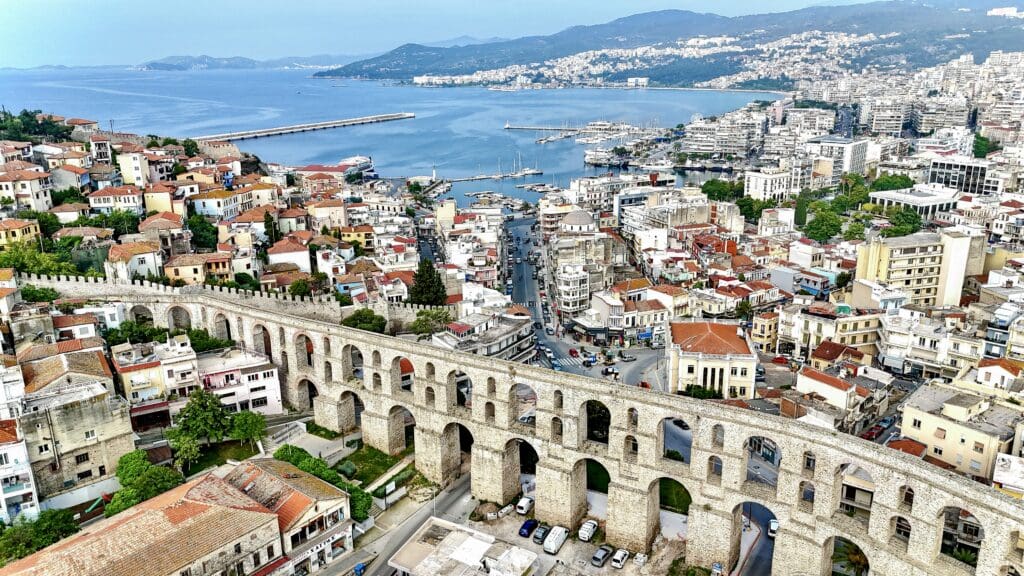
An evocative memory of Ancient Rome awaits your discovery on the easternmost edge of mainland Greece.
In the Greek Region of Eastern Macedonia and Thrace, the Aqueduct of Kavala began as a Roman bridge about 2,000 years ago.
Ancient Romans built the original aqueduct bridge when Kavala was known as Neapolis starting in the 2nd century BC.
Following the Roman and Byzantine centuries, the Ottomans rebuilt the stone aqueduct bridge over a decade.
Opened in 1530, the two-story stone aqueduct extends in a gentle curve 919 feet (280 m) long and 82 (25 m) high.
Along its elegant expanse, 60 arches of different sizes create visual interest and present openings for vehicles and pedestrians to pass through.
The Aqueduct of Kavala no longer serves its original purpose as a water bridge. However, its grandeur and glory still dazzle and delight today.
Address: Aqueduct of Kavala | Ellinikis Dimokratias 8 | 65201 Kavala Greece
Aqueduct of Kavala Travel Tips
For immediate access to the Arches, the adjacent location of Tompazi 2 can’t be better – the Aqueduct is literally steps away.
Opened in 2024, Tompazi 2 is a luxurious little apartment that’s been newly and fully renovated by a local architect and interior designer.
Taking the upper floor of a two-story building – yes, stairs are necessary – the cozy residence boasts its own private entrance, a narrow balcony, and all-new amenities.
Check the dates and best rates for your stay HERE.
From the Aqueduct, you can walk downhill to the lively Kavala waterfront. Or head uphill to Kavala Fortress, the medieval heart of Kavala Old Town since Byzantine and Ottoman times.
Kavala Aqueduct: Notes on Greek Names
Kavala (Καβάλα) is fondly called “the Blue City” (Η Γαλάζια πόλη) because of its location on the beautiful Bay of Kavala.
The Aqueduct of Kavala (Υδραγωγείο Καβάλας) is often called the Old Aqueduct (Παλαιό Υδραγωγείο). Many locals simply call it the Arches (Καμάρες).
Bridges in Greece: History and Mythology
Modern bridge design and construction link the legendary history of Ancient Greece and the mist-shrouded age of Classical mythology.
Ancient Greek bridges are the oldest bridges in Europe – and in fact, make the list of oldest bridges in the world.
Surprisingly, the mythological deity of bridges isn’t Greek. Rather, it’s the Roman god Janus. Present-day scholars agree with ancient primary sources like Ovid on this point.
The Roman poet Ovid wrote definitive mythologies from the 1st century BC to the 1st century AD, for example, his holiday calendar Fasti and his epic poem Metamorphoses.
With two heads facing in opposite directions, Janus sees the beginning and the end. Besides bridges, the ancient Romans additionally ascribed responsibility for doors, gates, passages, and transitions to Janus.
With this mythological origin in mind, it’s undeniably inspiring to discover ancient bridges in Greece that are thousands of years old – yet still intact and in use today!
•••
Interactive Map of Bridges in Greece
Bridges in Greece: Ancient Sources
Ovid, Fasti: A New Translation by Anne and Peter Wiseman, Oxford World’s Classics, Oxford University Press, 2013.
Ovid, Metamorphoses. Translated by David Raeburn, Penguin Classics, Penguin Publishing Group August 3, 2004.
Pausanias, Guide to Greece Volume 1: Central Greece. Translated by Peter Levi, Penguin Classics, Penguin Publishing Group, 1984.
Pausanias, Guide to Guide Volume 2: Southern Greece, Penguin Classics. Translated by Peter Levi, Penguin Publishing Group, 1984.
Bridges in Greece: Modern Resources
Morand, Pierre, et al., “The Rion-Antirion Bridge: Concept, Design, and Construction,” Structures Congress, New York, 2005.
Rosetta Stone, Greek Language Instruction Software: Learn Unlimited Languages with Lifetime Access. Rosetta Stone, 2019.
Vlachos, Savvas, et. al., “Design of the Tsakona Arched Bridge: Engineering for Progress, Nature, and People,” IABSE Symposium, Madrid, 2014.
Check Out More Recommendations
GET: Now that you’re ready to visit unique and beautiful bridges in Greece, get your exclusive free storytelling guide to tell your travel stories easily.
•••
Bridges in Greece: FAQs
What are the most famous Greek bridges?
Two of the most famous Greek bridges are firstly, the Rio-Antirio Bridge, officially named the Charilaos Trikoupis Bridge, which opened in August 2004 as the world’s longest cable-stayed bridge. Secondly, the Ancient Greek bridges built by the Myceneans in the 13th to 12th century BC are the oldest bridges in Greece and Europe.
What is the oldest bridge in Europe still in use?
The oldest bridge in Europe still in use is the Arkadiko Bridge in Greece. The Bronze Age Myceneans built the bridge in the Bronze Age, circa 1300 BC to 1190 BC. Thousands of years later, this ancient Greek bridge for chariots is still used as a bridge for pedestrians.
What are the longest bridges in Greece?
The longest bridge in Greece is the Rio-Antirio Bridge, officially named the Charilaos Trikoupis Bridge, at 2,252 m (1.4 miles) in total length. Another of the longest bridges in Greece is the Lake Polyfytos Bridge, also called the Servia High Bridge, at 1,372 m (0.85 miles) total length.

All opinions expressed are Spotlight Sojourns’ own.
All content and images are original, created with care by yours truly, Marilee Kostadimas and Paul Kostadimas. We’re the Hidden Gemologists® of Spotlight Sojourns: Award-winning travel experts and slow travel storytellers. Because slow travel is meaningful travel, part of a meaningful life. And stories enrich the meaning.

